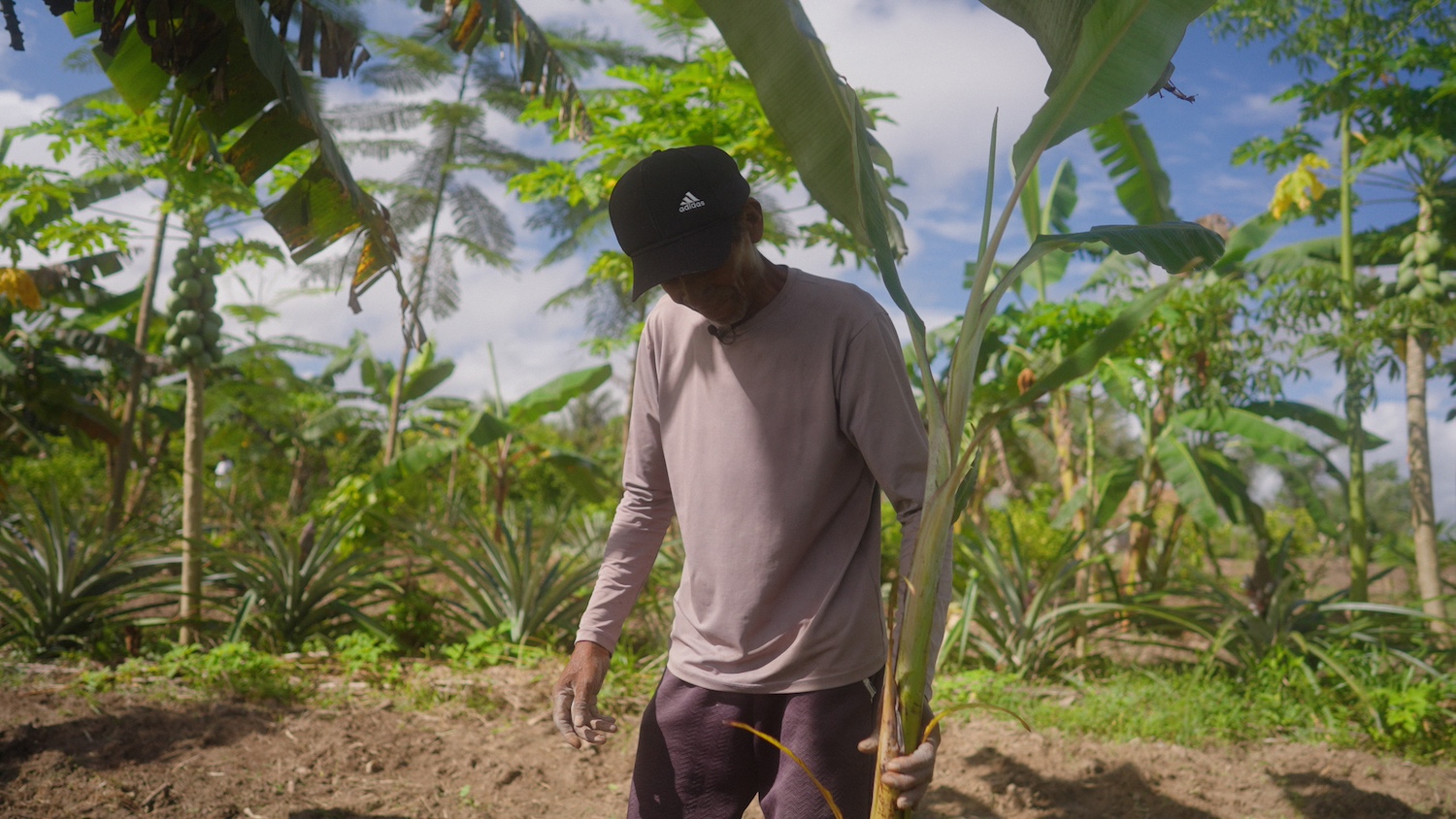
FarFarm farmers in Pará, Brazil, take an agroforestry approach to growing cotton, planting over 20 different species alongside it. (Image courtesy of FarFarm.)
Known as the jewels of the Earth, tropical rainforests are chock-full of resources. Our largest rainforest, the Amazon, contains 10 percent of the world’s wildlife species and about 20 percent of the total carbon stored in all terrestrial vegetation. If conserved, it provides $8.2 billion per year in economic benefits.
Despite its value, the region is under threat from warming temperatures, changes in rainfall, droughts, fires and deforestation. Consequently, the Amazon rainforest is losing resilience, and 10 to 47 percent may become savannas or degraded forests by 2050.
Yet, there’s a spark of hope. The Brazilian company FarFarm is turning to an unlikely hero: fashion. It launched an experimental agroforestry system growing organic cotton alongside trees, food and cash crops. After the cotton is harvested, the French footwear company Veja buys it to make sustainable sneakers.
With this tree-filled system, FarFarm and Veja aim to regenerate a slice of the 44 to 60 percent of the Amazon that’s deforested or degraded. Plus, the partnership provides traditional communities from African and Indigenous backgrounds with a viable income and food security.
FarFarm’s agroforestry approach
Inspired by the movement for sustainable cotton in Brazil, FarFarm started its agroforestry system in the northern state of Pará in 2017.
“We're planting over 20 different species together with cotton,” said Beto Bina, CEO and co-founder of FarFarm. “We use the cotton as a cash crop to push agroforestry. So in the alleys of perennial trees, we plant lots of different things, but we also focus on species that provide more market opportunities.”
For instance, they plant crops like cacao trees, Brazil nut trees, açai palms, timber trees and cupuaçu fruit trees. The organic cotton also demands a premium price and grows quickly, needing only four to six months from planting to harvest. But cotton is only the first step in the system.
“The idea is that these [tree] lines are going to grow and shape the cotton,” Bina said. “Then we take the cotton out of the system and use different species that like shade more between these alleys.”
Cotton prefers full sunlight, so after a few years of tree growth and increased shade, it needs to be replaced. The families FarFarm works with have, on average, 200 hectares of land, a lot of which is degraded, Bina said. So when cotton is shaded out of a plot, they move to another degraded area and replant it.
But agroforestry is not always a walk in the park. One challenge the company faces is the lack of technology.
“The families, they do everything by hand. They plant by hand,” Bina said. “We don't have machinery designed and developed for smallholder agroforestry. So everything takes a lot of time … We scale through the families, but we need to have more technology and machinery involved so they are able to work with less effort.”
Nonetheless, FarFarm has agroforestry projects in three biomes so far. While the Veja partnership already involves 100 families from three communities, the organizations hope to scale up. They need more funding partners and clients to do so.
From the Amazon to Paris
Once the cotton is harvested and processed, its second life begins as a fashionable sneaker. Founded by two Parisians, Veja was unique from the start.
“They wanted to imagine a different model in the fashion industry that would be environmentally friendly and also combined with social justice, so really something different from most of the fashion industry that we unfortunately know,” said Violette Combe, Zelar director of impact projects at Veja.

Veja is involved in multiple environmental initiatives, from shoe repair to sustainable rubber tapping. They ensure the sustainability of their products in several ways.
“We work with certification systems, so the organic certification, the Fair Trade principles, Fair for Life certification,” Combe said. “Yet, I would say that for us, the main guarantee is the relationship, the close relationship we built with the producers and the cooperatives.”
Veja has dedicated teams in the field working with farmers and producers, Combe said. For instance, Veja’s team, which has 20 years of experience with cotton, helped with capacity building for the FarFarm agroforestry project.
In addition to minimizing their environmental footprint, Veja also takes the social side of things seriously. It establishes multi-year contracts with its farmers and pays them an above-market price. It’s also committed to transparency, listing everything from wages to contracts on its website.
The increased price for raw materials challenged its sustainable business model. But in an exceptional move, the company compensated by cutting out all marketing.
“It enables us to redistribute everything that is saved on the marketing and advertising to production and smallholder funding,” Combe said. “That's why we can pay people the best wages and fair prices.”
Advantages of agroforestry
The partnership between FarFarm and Veja assists farmers in a variety of ways. Since they plant food crops like corn, pumpkin, beans and sesame seeds in their plots, they’ve increased their food security, Bina said. Previously, many of the families only grew monocultures.
The variety of both annual and perennial crops also diversifies farmers’ incomes and provides a monetary boost.
“We noticed a 50 percent income increase compared with the families from the same region who are not involved in the program,” Bina said. “It's a lot because they don't have many opportunities there. The families pretty much did yucca and right now they're sending 20 different species through the market.”
This increase aligns with research that shows agroforestry can boost crop productivity and profits on a farm.

Planting organic crops avoids pesticide use, too. That’s no small feat for cotton, also known as the world’s dirtiest crop. Cotton farming accounts for nearly 5 percent of pesticide sales and 10 percent of insecticide sales globally, according to the Better Cotton Initiative. Pesticides can pose serious environmental and human health risks. Cotton is also normally a thirsty crop, but these tropical systems don’t use any irrigation.
FarFarm’s model provides employment for communities in their local environment, too.
“If we compare our project with other reforestation projects, our projects are just a really small amount of land,” Bino said. “I think for us, the most inspiring thing is we're building a value chain that becomes autonomous, that provides jobs, and people can stay in the communities.”
Environmental perks
In addition to farmers, agroforestry benefits the surrounding environment. It supports higher levels of mammalian diversity than land under pure forestry or intensive agriculture. Plus, birds, insects, reptiles and amphibians fare better under agroforestry than monocultures. And these critters help with a common agricultural problem: pests.
“Because of the perennial trees, there's a lot of birds, and the birds eat the cotton boll weevil,” Bino said. “It's a beetle that's a major pest we have in cotton. We could notice a huge decrease in this pest because there are so many birds that eat the insect.”
Besides controlling crop damage, agroforestry provides other advantages.
“When you have different types of species you boost, of course, the quality of the soil, which increases the carbon sequestration in the soil, as well as increases biodiversity, water availability and also scenic beauty,” Bina said.
While agroforestry is not a carbon copy of a forest, it does restore forest cover and increase stocks of biomass, helping mitigate climate change. Since water evaporates from leaves, reforestation could also help prevent rainfall from declining in the region. The forest triggers a rainy season months earlier than would occur otherwise.
Agroforestry as a solution
Unfortunately, the Amazon lost a fifth of its forest cover over the last 50 years. A key to helping this lush ecosystem is working with those living there — over 40 million people speaking over 300 languages.
“I think the major problem in the Amazon is a lack of strategy because the families that live there, they don't have the opportunity to work with a standing forest,” Bina said. “Just to give you an idea, 95 percent of the jobs, the rural jobs in the Amazon, are related to industries that don't work with this standing forest, which is like mining, logging, oil … So if you are a young person who wants to work in the rural Amazon, you don't have opportunities to work with forestry, with agriculture.”
Thanks to FarFarm and Veja, now they do.

Ruscena Wiederholt is a science writer based in South Florida with a background in biology and ecology. She regularly writes pieces on climate change, sustainability and the environment. When not glued to her laptop, she likes traveling, dancing and doing anything outdoors.














